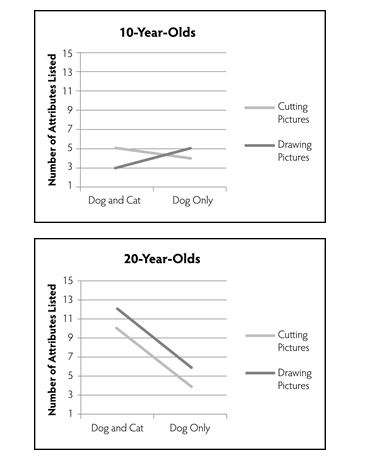RESEARCH STUDY 11.2
(The first paragraph is repeated from earlier. The second paragraph is specific to the new set of questions. The first paragraph is necessary to set up the original study.)
Dr. Elder was interested in the way people recognize objects as members of categories. For example, what makes us recognize a dog as being a dog and not a cat? More specifically, he was curious as to whether people think about categories in a more complex way if they contemplate an "opposite" category first. For example, does a person think more differently about the category of "southern" if they are also thinking about the category of "northern"? He is also curious as to whether people categorize differently if they are exposed to category members compared with generating category members. Dr. Elder has four groups of participants (with 30 people in each group). In Group A, participants were told to cut out pictures of dogs and cats from magazines. In Group B, participants were told to cut out pictures of just dogs from magazines. In Group C, participants were told to draw pictures of cats and dogs. In Group D, participants were told to draw pictures of just dogs. After doing this for 30 minutes, participants in all groups were asked to list the attributes that define the "dog" category. Having a higher number of attributes listed was considered to be an indication of thinking about the category in a more complex way.
Dr. Elder also is curious as to whether categorization happens similarly for children as it does for adults. As such, he recruits a group of 10-year-olds and a group of 20-year-olds to participate in the study. The results are below.

-Refer to Research Study 11.3 above to answer the following question.
Using the data table alone,discuss whether Dr.Lopez should conclude that an interaction exists in his study.
Definitions:
Mentor Or Sponsor
A relationship in which an experienced individual (mentor or sponsor) provides guidance, advice, and support to a less experienced person to help them progress in their career or personal development.
Developmental Groups
Groups focused on the growth and development of their members, often through shared learning experiences, skill-building activities, or supportive interactions.
Psychological Groups
Collections of individuals who share emotional connections, common purposes, or identify as members of the same group.
Cohesive Groups
Groups characterized by strong interpersonal bonds among members, leading to high levels of cooperation and team effectiveness.
Q6: To find a city street,a small-scale map
Q15: Which of the following is NOT a
Q21: The country of _ is South America's
Q28: A local committee that reviews research that
Q31: Which of the following is another term
Q31: When conducting an experiment,what is provided by
Q32: Middle America's largest country today in terms
Q39: According to Figure G-5,which U.S.city was NOT
Q49: If researchers measure every tenth member of
Q70: An index of regional disparity would be